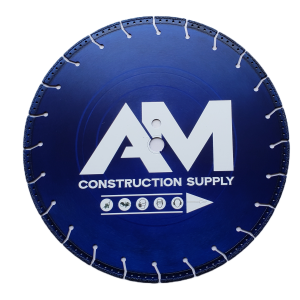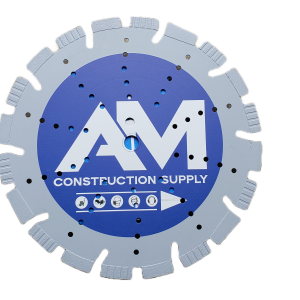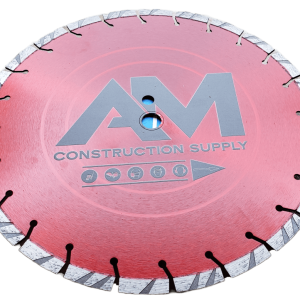Ever wondered how to cut through the toughest surfaces with precision and ease? Enter the world of the 24 asphalt diamond saw blade, a game-changer for professionals and DIY enthusiasts alike. This powerhouse tool slices through asphalt like butter, making it a must-have in your arsenal. With its unparalleled durability and cutting efficiency, it’s designed to tackle even the most challenging projects without breaking a sweat. Whether you’re laying down a new driveway or undertaking a major construction project, understanding how this blade works can significantly impact your work’s quality and speed. Let’s dive into what makes the 24 asphalt diamond saw blade your go-to tool for any heavy-duty cutting job.
Key Takeaways
- Understand the Basics: Knowing how diamond blades work is crucial for anyone in the construction or renovation industry. The unique properties of diamond segments allow for efficient and precise cutting of hard materials like asphalt.
- Size Matters: The 24-inch asphalt diamond saw blade is specifically designed for heavy-duty tasks, offering deep cuts and high durability. Ensure your projects match the capabilities of this blade size for optimal results.
- Compatibility Is Key: Not all saws are suitable for every blade. Verify that your saw can accommodate a 24-inch blade to avoid equipment damage or unsafe working conditions.
- Choose Wisely: Selecting the right blade involves understanding the specific needs of your project, including the material to be cut and the type of cut desired. Look for blades that offer the best balance between performance and longevity.
- Proper Installation and Use: Following correct installation and usage guidelines not only ensures safety but also maximizes the blade’s performance and lifespan. Always refer to the manufacturer’s instructions.
- Maintenance and Safety: Regular maintenance and adherence to safety measures extend the life of your blade and protect users from potential hazards. Simple practices like checking for wear and ensuring proper storage can make a significant difference.
Understanding Diamond Blades
Blade Components
High-quality diamond segments are crucial for the blade’s durability. These segments allow the blade to cut through tough materials like asphalt effortlessly. They are embedded in the blade’s edge, providing the cutting power needed.
The tensioned steel core plays a vital role in maintaining blade stability. It prevents the blade from warping or distorting during intense cutting sessions. This ensures consistent performance throughout its lifespan.
Laser-welded segments enhance the blade’s longevity and performance. This process binds the diamond segments securely to the steel core. It results in a stronger bond that can withstand high temperatures and tough cutting conditions.
Cutting Mechanism
Diamond edges grind through asphalt rather than cutting it traditionally. This grinding action allows for cleaner cuts with less effort. The precision and speed of cutting with a 24″ asphalt diamond saw blade are unmatched.
These blades are compatible with various saw types, offering versatile applications. Whether you’re using a handheld saw or a walk-behind model, these blades adapt seamlessly. This flexibility makes them a preferred choice for professionals.
Asphalt Specific Features
Design features specific to asphalt include segment height and composition. These aspects make the blades ideal for cutting through asphalt without causing damage. The segment height ensures deep cuts, while the composition is tailored to resist wear from abrasive materials.
The blade minimizes chipping and ensures a smooth cut on asphalt surfaces. This precision results in clean edges and reduces material waste during projects.
Its resistance to the abrasive nature of asphalt extends its life significantly. Users can expect consistent performance over time, making it a cost-effective solution for long-term use.
Key Specifications of 24-Inch Blades
Blade Thickness
The thickness of a 24-inch asphalt diamond saw blade plays a crucial role in its cutting performance and stability. Thicker blades are more stable and less prone to wobbling, making them ideal for heavy-duty cutting tasks. They can handle more pressure and are less likely to break or warp during intense operations. In contrast, thinner blades offer greater precision and are easier to maneuver, which is beneficial for intricate cuts.
Choosing the right blade thickness is vital for optimal cutting efficiency. For instance, thicker blades are preferred for deeper cuts in tough materials like asphalt, ensuring smoother operations without compromising on speed or quality. It’s important to match the blade thickness with the specific needs of your project to achieve the best results.
Segment Height
The segment height of a blade significantly impacts its lifespan and performance. Taller segments allow for deeper cuts, extending the blade’s usable life by enabling it to wear down further before needing replacement. This feature is particularly valuable when working with abrasive materials like asphalt that can quickly diminish a blade’s effectiveness.
There’s a balance between segment height and cutting speed; taller segments may reduce the speed slightly but offer longer blade life, making them more cost-effective in the long run. High segment heights are an investment in durability, ensuring that your 24-inch asphalt diamond saw blade remains effective over many projects.
Wet vs Dry Cutting
Understanding when to employ wet or dry cutting techniques is essential for maximizing the utility of your 24-inch asphalt diamond saw blade. Wet cutting is preferable for jobs where dust suppression and cooling are priorities, as water helps minimize airborne particles and keeps the blade from overheating. However, this method requires access to water and cleanup post-cutting.
Dry cutting stands out for its convenience and speed, suitable for situations where setting up water cooling systems is impractical. The design of blades intended for both environments incorporates features that enhance their performance under respective conditions. Safety should always be a top consideration; wet cutting reduces dust exposure risks, while dry cutting demands protective measures against dust inhalation.
Design and Technology
Laser-Welded Segments
The use of laser-welding technology in crafting 24-inch asphalt diamond saw blades brings several pivotal benefits. Firstly, it creates stronger bonds between the diamond segments and the blade core. This bond is crucial for maintaining the integrity of the blade under high-speed cutting conditions.
Laser-welded segments also significantly enhance the blade’s durability. They allow it to withstand rigorous cutting tasks without succumbing to wear and tear quickly. This means operators can push the blade to higher speeds, achieving more efficient cuts over time.
Safety is another critical advantage. Blades with laser-welded segments are less prone to segment loss during operation. This reduces the risk of accidents, making them a safer choice for construction sites.
Tensioned Steel Core
At the heart of every 24-inch asphalt diamond saw blade lies its tensioned steel core. This component is essential for preventing blade warping during intense cutting sessions. Warped blades can lead to imprecise cuts and potentially damage the material being cut or even the cutting equipment itself.
The tensioned steel core contributes significantly to the blade’s overall stability and precision. It ensures that each cut is as accurate as possible, which is vital for professional applications where precision matters most.
Manufacturers employ specialized processes to ensure that each steel core’s tension is optimal for cutting performance. This involves carefully balancing the metal’s properties to achieve a balance between flexibility and rigidity, ensuring that the blade can handle various cutting scenarios without losing its shape or efficiency.
Compatibility with Saw Types
Handheld Saws
The 24″ asphalt diamond saw blade is a robust tool, designed to fit handheld saws perfectly. Its size and weight are balanced for these tools, ensuring a good grip and manageability during cutting tasks. They make precision cuts on smaller projects not just possible but highly efficient.
Handheld saws paired with this blade excel in delivering sharp, precise cuts. This combination is ideal for intricate work where detail matters. Users can maneuver the saw easily, making it perfect for tight spaces or complex patterns.
Ergonomics play a crucial role when using this large blade with handheld saws. The design of the handle and the weight distribution of the saw need to consider user comfort and fatigue reduction. This ensures longer periods of use without strain, making the job smoother and more enjoyable.
Walk-Behind Saws
When it comes to larger projects requiring deeper cuts, the 24″ asphalt diamond saw blade and walk-behind saws are a match made in heaven. These blades are built for deep penetration, making them suitable for tackling large areas of asphalt with ease.
Walk-behind saws offer consistent, straight cuts over long distances. This makes them indispensable for jobs requiring uniform depth and precision across extensive surfaces. The benefits here include not just accuracy but also speed and efficiency in execution.
Safety features become paramount when using such a powerful combination. Look for walk-behind saws equipped with protective guards and emergency stop functions. These features ensure that operators can manage the equipment safely while harnessing its full potential with a 24″ blade.
Selecting the Right Blade
Assessing Project Needs
Before choosing a 24 asphalt diamond saw blade, it’s crucial to evaluate your project’s scope. The thickness and segment height of the blade play significant roles in determining its effectiveness. Thicker blades are durable but may reduce cutting speed, while taller segments allow for deeper cuts.
It’s also vital to consider the asphalt type and condition. Fresh, soft asphalt requires a different approach than older, hardened surfaces. Understanding these nuances ensures you select a blade that matches your needs.
Matching the blade to your saw’s power is another key factor. A high-powered saw can handle thicker blades without compromising performance. This alignment between tool and accessory maximizes efficiency and extends the life of both.
Material Considerations
Asphalt composition greatly influences blade choice. Different mixes of asphalt have varying effects on cutting performance. For instance, softer asphalts tend to clog blades, requiring ones with wider gullets for efficient debris removal.
The hardness of the aggregate within the asphalt impacts both wear rate and cutting speed. Harder aggregates demand blades with tougher diamonds to maintain cutting efficiency without rapid wear.
For reinforced asphalt containing metal bars or mesh, specialized blades are necessary. These blades have segments designed to cut through both the asphalt and reinforcement without damage. Their unique composition ensures smooth cuts and longevity, even in challenging conditions.
Installation and Usage Tips
Proper Installation
Installing a 24-inch asphalt diamond saw blade requires careful attention to ensure safety and efficiency. Begin by turning off the power to your saw. This prevents accidental starts during installation. Next, remove any existing blade with the appropriate tools, typically provided with your saw.
For proper installation, align the new blade with the arbor hole accurately. This alignment is crucial for precise cuts. Once aligned, secure the blade tightly in place. A loose blade can lead to dangerous accidents.
After securing, perform an alignment check. Spin the blade by hand to ensure it moves freely without wobbling. Any misalignment can cause uneven cuts and damage both the blade and the asphalt.
Operating Speeds
Determining the optimal operating speed for your 24-inch asphalt diamond saw blade depends on several factors. The diameter of the blade and power of the saw play significant roles in this decision.
For efficient cutting, refer to the manufacturer’s guidelines on recommended speeds. Generally, a larger diameter requires lower speeds to maintain precision in cutting asphalt surfaces.
Operating at incorrect speeds risks premature wear or inefficient cutting. High speeds may cause overheating, while too slow speeds can result in unproductive cutting efforts.
Maintenance Best Practices
Cleaning Techniques
Proper cleaning of your 24 asphalt diamond saw blade is crucial. It ensures optimal performance and extends its lifespan. After each use, remove asphalt residue to prevent build-up. This residue can harden over time, making future cuts less efficient.
For effective cleaning, soak the blade in a simple solution of water and mild detergent. Avoid harsh chemicals that might damage the blade’s metal. Use a soft brush to gently scrub off any stubborn asphalt particles. Rinse it thoroughly with clean water and dry it completely before storage.
Storage Solutions
Storing your 24 asphalt diamond saw blade correctly is as important as cleaning it properly. Proper storage prevents damage and ensures the blade is safe and ready for next use.
Always store blades in a dry, cool place to avoid corrosion. Moisture is a major enemy of metal tools, including diamond saw blades. Use protective covers to safeguard the blade’s edges from chips or dents. These covers also protect users from accidental cuts when handling the blades.
Safety Measures
Protective Gear
When operating saws with a 24″ asphalt diamond saw blade, wearing the right protective gear is crucial. Essential items include:
- Safety glasses or goggles
- Ear protection such as earmuffs or earplugs
- Durable gloves
- Long-sleeved clothing
These items protect your eyes and ears from the high noise levels and flying debris. Gloves and long sleeves shield your hands and arms from sparks and rough materials.
For tasks that generate a lot of dust, especially during dry cutting, a proper respirator or mask is a must. It prevents inhaling harmful particles. This step is vital for your lung health.
Safe Operating Procedures
Before using an asphalt diamond saw blade, inspecting the equipment is key. Look for any damage to the blade or saw. This check ensures everything is in working order.
Always maintain a firm grip on the saw. A stable stance is also essential while cutting through tough materials like asphalt. These practices prevent accidents and ensure precise cuts.
Be familiar with the emergency stop procedures of your equipment. Always be aware of your surroundings to avoid injuries to yourself or others nearby.
Prolonging Blade Life
Regular Inspections
Regular inspections are crucial for maintaining the lifespan of a 24 asphalt diamond saw blade. These checks help identify wear, damage, or signs of fatigue early on. It’s important to closely examine both the segments and the core for any cracks, warping, or other irregularities.
If you notice any issues during inspection, it’s vital to address them immediately. Replacing the blade promptly when safety concerns arise ensures not only the longevity of your equipment but also the safety of its users. This proactive approach prevents minor damages from escalating into major problems.
Avoiding Common Mistakes
Using the correct blade for specific materials and saw types is essential. A common mistake is using a blade designed for concrete on asphalt surfaces or vice versa. Such errors can significantly shorten the blade’s life and compromise cutting efficiency.
Operating the saw at incorrect speeds or without adequate water supply during wet cutting poses risks too. It leads to overheating and premature wear of the blade. Proper installation and alignment are equally critical; they prevent uneven wear and potential accidents.
Final Remarks
Selecting, installing, and maintaining a 24-inch asphalt diamond saw blade is no small feat. You’ve navigated through understanding the blade’s design, ensuring it matches your saw type, and learned how to extend its life through proper use and maintenance. This knowledge not only saves you time and money but also enhances safety on your projects. Remember, the right blade can make all the difference in the quality and efficiency of your work. Trust in the specifications and tips shared here to guide you in making informed decisions for your cutting needs.
Now, armed with this expertise, you’re set to tackle any cutting job with confidence. Don’t let blade selection slow you down. Embrace these insights, choose wisely, and see how a well-maintained diamond saw blade can revolutionize your work. Ready for smoother cuts? It’s time to put this knowledge into action. Dive into your next project with the perfect 24-inch asphalt diamond saw blade.
Frequently Asked Questions
What are diamond blades and why are they used?
Diamond blades are cutting tools with diamonds fixed on the edge, designed for cutting hard or abrasive materials such as asphalt, providing clean cuts with high efficiency.
What makes a 24-inch diamond saw blade special?
A 24-inch diamond saw blade offers a larger cutting depth, ideal for heavy-duty tasks, ensuring precision and speed in large-scale projects.
How do I know if a 24-inch blade will fit my saw?
Check your saw’s specifications for maximum blade diameter compatibility. Most industrial concrete and road saws support 24-inch blades, but it’s crucial to verify beforehand.
What should I consider when selecting a 24-inch asphalt diamond blade?
Focus on the blade’s bond hardness, diamond concentration, and segment shape. These factors determine the blade’s cutting ability, speed, and lifespan for asphalt projects.
Can you provide tips for installing a 24-inch diamond saw blade?
Ensure the saw is off and unplugged. Align the blade’s arbor hole with the saw’s arbor shaft correctly. Tighten securely following the manufacturer’s instructions to prevent slippage or accidents.
How often should I maintain my 24-inch diamond saw blade?
Regular maintenance after each use is recommended. Cleaning the blade and checking for wear or damage extends its life and maintains optimal performance.
What safety measures should I take when using a diamond saw blade?
Always wear protective gear including gloves, eye protection, and ear protection. Ensure the work area is secure and follow all safety guidelines provided by both the saw and blade manufacturers.





